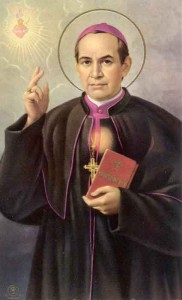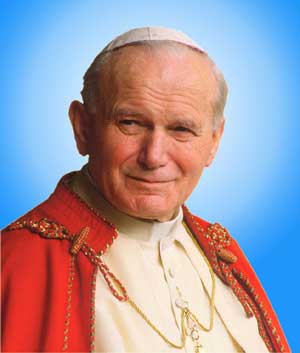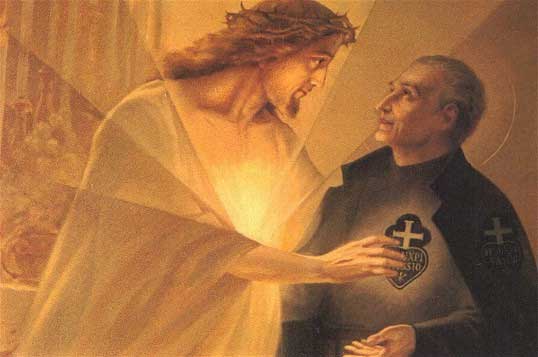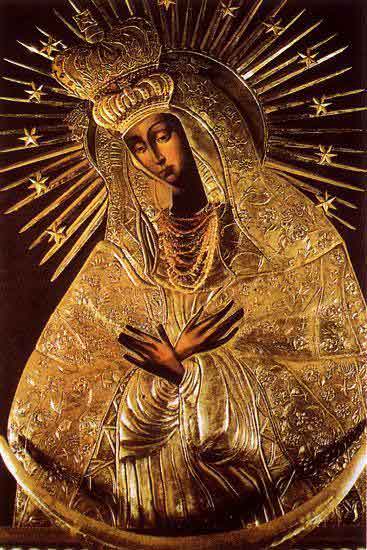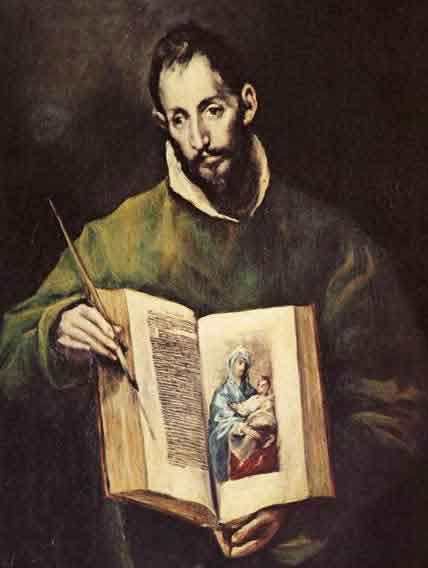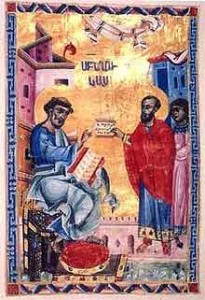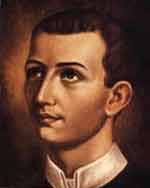“Dispose the day…” OK, I really didn’t understand the significance of St. Crispin and St. Crispinian except for their presence in the robust guy “band of brothers” speech from Shakespeare’s Henry V…very macho “rouse the troops” moment in the play… I just figured they were warriors too…(besides I’m more of a  “Midsummer Night’s Dream” kind of Shakespeare girl anyway…)
                         Â
 That is until I read Omar F. A. Gutierrez’s fantastic blog post bringing it all together! Treat your brain and heart by visiting his blog  Regnum Novum
That is until I read Omar F. A. Gutierrez’s fantastic blog post bringing it all together! Treat your brain and heart by visiting his blog  Regnum Novum
Here, once again, is Omar Guiterrez breaking open for Discerning Hearts the beauty of Catholic Social Doctrine….
(it’s amazing where you can find it if you have eyes to see and ears to hear)
Today marks the feast of Saints Crispin and Crispian, brothers who were martyred by beheading in Rome sometime during the reign of the Emperor Diocletian (emperor from 284-305 AD).
That the saints lived is certainly true. The story of these brothers, however, comes to us from a late account that has little to suggest it’s authenticity. Generally, though, we know them to be from Rome, to have worked in Soissons, Gaul (now France), and to have been shoemakers thus earning them the title of patrons for shoemakers, cobblers, and those who work with leather.
The tale is that these two brothers, perhaps twins of noble blood, caught up in the zealous care for their faith and in love for Christ, left Rome in the 3rd century in order to spread the Gospel in Gaul. They took up the trade of the shoemaker and would not charge the poor who requested their services. By their example, and not, it seems,by any grand preaching, these two were good witnesses to the faith and converted many. When Maximian was appointed co-emperor in 285 and came to Gaul, the brothers were accused and brought before a character named Rictiovarus, whom we don’t exactly know existed but whose seathing hatred for Christians is legendary. At any rate, they were tortured mercilessly, but when the attempt to kill the saintly brothers through drowning and burning failed, Rictiovarus was driven into such a desperate fury that he threw himself into the fire prepared for the brothers thus killing himself. Eventually, Crispin and Crispian were beheaded which is a very effective way of killing someone…unless you’re St. Winifred, in which case that might not always work.  There are several things I’d like to draw out about these saints.
The first is that it was on this day 595 years ago (1415) that King Henry V led his horribly outnumbered English army into battle against the French at Agincourt, the battle so wonderfully remember today for the speech written by Shakespeare in Henry V,( a version of which can be seen above with Kenneth Branagh.)
The second thing is this, brought out in an edition of Butler’s Lives of the Saints, namely that Sts. Crispin and Crispian are a wonderful reminder that sanctity is not only for the cloistered hermit who has removed himself from society. These two never embarked on some large speaking tour throughout Gaul. They did not write any large tomes explicating the faith for the masses. They are not known for levitating or bilocation or magically producing shoes no one today can replicate with all our modern technology. No, they were simply saintly shoemakers. They were holy artisans is all, and this is a good thing. In this way they are almost the perfect patron saints for laborers, heroes of the Social Doctrine of the Church.
I’m reminded of a line from the Part I Chapter 3 of St. Francis de Sales’ classic Introduction to the Devout Life where he says:
 It is an error, nay more, a very heresy, to seek to banish the devout life from the soldier’s guardroom, the mechanic’s workshop, the prince’s court, or the domestic hearth. Of course a purely contemplative devotion, such as is specially proper to the religious and monastic life, cannot be practised in these outer vocations, but there are various other kinds of devotion well-suited to lead those whose calling is secular, along the paths of perfection. The Old Testament furnishes us examples in Abraham, Isaac and Jacob, David, Job, Tobias, Sarah, Rebecca and Judith; and in the New Testament we read of St. Joseph, Lydia and Crispus, who led a perfectly devout life in their trades:–we have S. Anne, Martha, S. Monica, Aquila and Priscilla, as examples of household devotion, Cornelius, S. Sebastian, and S. Maurice among soldiers;–Constantine, S. Helena, S. Louis, the Blessed Amadaeus, 2 and S. Edward on the throne. And we even find instances of some who fell away in solitude,– usually so helpful to perfection,–some who had led a higher life in the world, which seems so antagonistic to it. S. Gregory dwells on how Lot, who had kept himself pure in the city, fell in his mountain solitude. Be sure that wheresoever our lot is cast we may and must aim at the perfect life.
Sanctity can be found through the work which God has given us no matter what that might be. Indeed it is to be found in the guardroom, in the shop, in the court, in the home. This is the message of the Social Teaching of the Catholic Church. Sanctity and evangelization can be found through the labor of everyday life. It is less what you do than the way you do it, and the way to do anything is with the love of Christ.
Third, I want to point out that with saints whose stories are in doubt it can be tempting to write them off as the incipient pap of bygone days. There are some who actually claim that the Church has managed its control over the laity throughout the centuries by inventing such stories. I’m not making that claim, but many are tempted to think that there never was such a saint, or that we cannot glean any lesson from them, or that, poor bumpkins that they were, those ignoramuses of the early years of the Church meant well if they weren’t always truthful. This sort of temptation is what Chesterton called “chronological snobbery.†Somehow we image that in our Enlightened age we appreciate truth much more than the people of the early centuries. This would be a terrible mistake.
Stories do evolve over time, and tales can be embellished but we should never forget three things: first, that the stories were told because of some real event or real person, even if we don’t remember their name and even if our collective memories have gotten the details wrong. Second, the miraculous is not impossible. We believe in things seen and unseen, so why presume the fantastical must be unreal? Third, someone in heaven answers to the name of these saints in question. That’s what matters.  – Regnum Novum
Thanks Omar! My visits to DSW will never be the same again.
Tags: catholic, catholic podcast, catholic prayer, catholic social doctrine, cathollc spirituality, christians, emperor diocletian, guiterrez, henry v, st crispin
This entry was posted on Tuesday, October 25th, 2011 at 10:16 am
You can follow any responses to this entry through the RSS 2.0 feed.
Incorruptible Bodies of Saints
[powerpress “faith-check-with-greg-youell”]
‘Remember o man that you are dust, and to dust you shall return.’  We hear these words each Ash Wednesday to remind us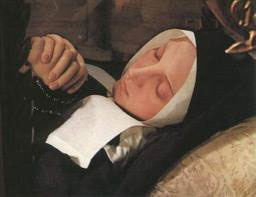 of death and judgment awaiting us all.  While our bodies are the source of so much focus in our culture, they will decay into dust, until they are ultimately resurrected and reunited with our souls at the end of the world.
of death and judgment awaiting us all.  While our bodies are the source of so much focus in our culture, they will decay into dust, until they are ultimately resurrected and reunited with our souls at the end of the world.
God has granted exceptions to this, however, in the “incorruptiblesâ€â€”saints whose bodies are miraculously preserved in tact after death, as a visible sign of their holiness.  These miracles have withstood in-depth scientific and medical examinations that rule out any possible hoaxes and make clear that they are entirely distinct from those bodies preserved through extreme temperatures or mummification.
When St. Bernadette Soubirous of Lourdes was examined in 1909, thirty years after her death, her body appeared the same as when she had been alive: her body was odorless and her skin was supple and had coloration—while the rosary in her hands had rusted over.  Today her body can still be observed and pilgrims state that looks as if she were merely asleep.
And then there’s the St. Anthony of Padua.  Years after his death his body had decayed, but God had preserved the great preacher’s tongue alone—those present reported that it was perfectly pink.
Tags: catholic, catholic podcast, catholic prayer, cathollc spirituality, miracles
This entry was posted on Monday, October 24th, 2011 at 2:23 pm
You can follow any responses to this entry through the RSS 2.0 feed.
‘The love of Christ arouses us, urges us to run, and to fly lifted on the wings of holy zeal . . . The man who burns with the fire of divine love is a son of the Immaculate Heart of Mary, and wherever he goes, he enkindles that flame; he desires and works with all his strength to inflame all men with the fire of God’s love. Nothing deters him: he rejoices in poverty; he labors strenuously; he welcomes hardships; he laughs off false accusations; he rejoices in anguish. He thinks only of how he might follow Jesus Christ and imitate Him by his prayers, his labors, his sufferings, and by caring always and only for the glory of God and the salvation of souls.’ – St. Anthony Mary Claret
A remarkable saint…St. Anthony Mary Claret who lived during the turblent years of the 1800’s in Latin America, namely Cuba. He had a great love for the Blessed Virgin Mary and her Immaculate Heart. More on his life can be found here…
Tags: anthony mary claret, blessed virgin mary, catholic, catholic podcast, catholic prayer, cathollc spirituality, Church, immaculate heart of mary, jesus christ, latin america, love, St. Anthony Mary, St. Anthony Mary Claret, sufferings
This entry was posted on Monday, October 24th, 2011 at 12:52 am
You can follow any responses to this entry through the RSS 2.0 feed.
 The lyrics and translation are as follows:
The lyrics and translation are as follows:
Hail Mary, full of grace, the Lord is with thee.
Blessed art thou amongst women, and blessed is the fruit of thy womb, Jesus.
Holy Mary, Mother of God, pray for us sinners, now and at the hour of our death.
Amen
Ãve MarÃa, grátia pléna, Dóminus técum.
BenedÃcta tu in muliéribus, et benedÃctus frúctus véntris túi, Iésus.
Sáncta MarÃa, Máter Déi, óra pro nóbis peccatóribus, nunc et in hóra mórtis nóstrae.
Ãmen.
Tags: catholic, Catholic Hymns of Praise, catholic podcast, catholic prayer, cathollc spirituality, death, hail mary, Holy Mary, women
This entry was posted on Sunday, October 23rd, 2011 at 12:06 am
You can follow any responses to this entry through the RSS 2.0 feed.
Here is Pope Benedict XVI’s homily for the Mass of beatification:
Dear Brothers and Sisters,
Six years ago we gathered in this Square to celebrate the funeral of Pope John Paul II. Our grief at his loss was deep, but even greater was our sense of an immense grace which embraced Rome and the whole world: a grace which was in some way the fruit of my beloved predecessor’s entire life, and especially of his witness in suffering. Even then we perceived the fragrance of his sanctity, and in any number of ways God’s People showed their veneration for him. For this reason, with all due respect for the Church’s canonical norms, I wanted his cause of beatification to move forward with reasonable haste. And now the longed-for day has come; it came quickly because this is what was pleasing to the Lord: John Paul II is blessed!….
Today is the Second Sunday of Easter, which Blessed John Paul II entitled Divine Mercy Sunday. The date was chosen for today’s celebration because, in God’s providence, my predecessor died on the vigil of this feast. Today is also the first day of May, Mary’s month, and the liturgical memorial of Saint Joseph the Worker. All these elements serve to enrich our prayer, they help us in our pilgrimage through time and space; but in heaven a very different celebration is taking place among the angels and saints! Even so, God is but one, and one too is Christ the Lord, who like a bridge joins earth to heaven. At this moment we feel closer than ever, sharing as it were in the liturgy of heaven.
….
Dear brothers and sisters, today our eyes behold, in the full spiritual light of the Risen Christ, the beloved and revered figure of John Paul II. Today his name is added to the host of those whom he proclaimed saints and blesseds during the almost twenty-seven years of his pontificate, thereby forcefully emphasizing the universal vocation to the heights of the Christian life, to holiness, taught by the conciliar Constitution on the Church Lumen Gentium. All of us, as members of the people of God – bishops, priests, deacons, laity, men and women religious – are making our pilgrim way to the heavenly homeland where the Virgin Mary has preceded us, associated as she was in a unique and perfect way to the mystery of Christ and the Church. Karol WojtyÅ‚a took part in the Second Vatican Council, first as an auxiliary Bishop and then as Archbishop of Kraków. He was fully aware that the Council’s decision to devote the last chapter of its Constitution on the Church to Mary meant that the Mother of the Redeemer is held up as an image and model of holiness for every Christian and for the entire Church. This was the theological vision which Blessed John Paul II discovered as a young man and subsequently maintained and deepened throughout his life. A vision which is expressed in the scriptural image of the crucified Christ with Mary, his Mother, at his side.This icon from the Gospel of John (19:25-27) was taken up in the episcopal and later the papal coat-of-
arms of Karol WojtyÅ‚a: a golden cross with the letter “M” on the lower right and the motto “Totus tuus”, drawn from the well-known words of Saint Louis Marie Grignion de Montfort in which Karol WojtyÅ‚a found a guiding light for his life: “Totus tuus ego sum et omnia mea tua sunt. Accipio te in mea omnia. Praebe mihi cor tuum, Maria – I belong entirely to you, and all that I have is yours. I take you for my all. O Mary, give me your heart” (Treatise on True Devotion to the Blessed Virgin, 266).
In his Testament, the new Blessed wrote: “When, on 16 October 1978, the Conclave of Cardinals chose John Paul II, the Primate of Poland, Cardinal Stefan WyszyÅ„ski, said to me: ‘The task of the new Pope will be to lead the Church into the Third Millennium'”. And the Pope added: “I would like once again to express my gratitude to the Holy Spirit for the great gift of the Second Vatican Council, to which, together with the whole Church – and especially with the whole episcopate – I feel indebted. I am convinced that it will long be granted to the new generations to draw from the treasures that this Council of the twentieth century has lavished upon us. As a Bishop who took part in the Council from the first to the last day, I desire to entrust this great patrimony to all who are and will be called in the future to put it into practice. For my part, I thank the Eternal Shepherd, who has enabled me to serve this very great cause in the course of all the years of my Pontificate”. And what is this “cause”? It is the same one that John Paul II presented during his first solemn Mass in Saint Peter’s Square in the unforgettable words: “Do not be afraid! Open, open wide the doors to Christ!”
What the newly-elected Pope asked of everyone, he was himself the first to do: society, culture, political and economic systems he opened up to Christ, turning back with the strength of a titan – a strength which came to him from God – a tide which appeared irreversible. By his witness of faith, love and apostolic courage, accompanied by great human charisma, this exemplary son of Poland helped believers throughout the world not to be afraid to be called Christian, to belong to the Church, to speak of the Gospel. In a word: he helped us not to fear the truth, because truth is the guarantee of liberty. To put it even more succinctly: he gave us the strength to believe in Christ, because Christ is Redemptor hominis, the Redeemer of man. This was the theme of his first encyclical, and the thread which runs though all the others.
When Karol WojtyÅ‚a ascended to the throne of Peter, he brought with him a deep understanding of the difference between Marxism and Christianity, based on their respective visions of man. This was his message: man is the way of the Church, and Christ is the way of man. With this message, which is the great legacy of the Second Vatican Council and of its “helmsman”, the Servant of God Pope Paul VI, John Paul II led the People of God across the threshold of the Third Millennium, which thanks to Christ he was able to call “the threshold of hope”. Throughout the long journey of preparation for the great Jubilee he directed Christianity once again to the future, the future of God, which transcends history while nonetheless directly affecting it. He rightly reclaimed for Christianity that impulse of hope which had in some sense faltered before Marxism and the ideology of progress. He restored to Christianity its true face as a religion of hope, to be lived in history in an “Advent” spirit, in a personal and communitarian existence directed to Christ, the fullness of humanity and the fulfillment of all our longings for justice and peace.
Finally, on a more personal note, I would like to thank God for the gift of having worked for many years with Blessed Pope
John Paul II. I had known him earlier and had esteemed him, but for twenty-three years, beginning in 1982 after he called me to Rome to be Prefect of the Congregation for the Doctrine of the Faith, I was at his side and came to revere him all the more. My own service was sustained by his spiritual depth and by the richness of his insights. His example of prayer continually impressed and edified me: he remained deeply united to God even amid the many demands of his ministry. Then too, there was his witness in suffering: the Lord gradually stripped him of everything, yet he remained ever a “rock”, as Christ desired. His profound humility, grounded in close union with Christ, enabled him to continue to lead the Church and to give to the world a message which became all the more eloquent as his physical strength declined. In this way he lived out in an extraordinary way the vocation of every priest and bishop to become completely one with Jesus, whom he daily receives and offers in the Church.
Blessed are you, beloved Pope John Paul II, because you believed! Continue, we implore you, to sustain from heaven the faith of God’s people. You often blessed us in this Square from the Apostolic Palace: Bless us, Holy Father! Amen.
Tags: catholic, catholic podcast, catholic prayer, cathollc spirituality, pope benedict xvi, pope john paul ii, Second Vatican Council, virgin mary
This entry was posted on Saturday, October 22nd, 2011 at 6:55 am
You can follow any responses to this entry through the RSS 2.0 feed.
Join Fr. Joseph Michael Mary as he reflects upon the Message of Our Lady of Fatima and the dogma of Purgatory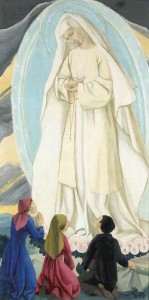
Tags: catholic, catholic podcast, catholic prayer, cathollc spirituality, confession, fatima, Fatima Reflections, Joseph Michael Mary, our lady of fatima, purgatory, reconciliation
This entry was posted on Saturday, October 22nd, 2011 at 12:01 am
You can follow any responses to this entry through the RSS 2.0 feed.
St. Paul of the Cross quotes:
When you feel the assaults of passion and anger, then is the time to be silent as Jesus was silent in the midst of His ignominies and sufferings.-St. Paul of the Cross
It is very good and holy to consider the passion of our Lord, and to meditate on it, for by this sacred path we reach union with God. In this most holy school we learn true wisdom, for it was there that all the saints learned it.-St. Paul of the Cross
Therefore, be constant in practicing every virtue, and especially in imitating the patience of our dear Jesus, for this is the summit of pure love. Live in such a way that all may know that you bear outwardly as well as inwardly the image of Christ crucified, the model of all gentleness and mercy. For if a man is united inwardly with the Son of the living God, he also bears his likeness outwardly by his continual practice of heroic goodness, and especially through a patience reinforced by courage, which does not complain either secretly or in public. Conceal yourselves in Jesus crucified, and hope for nothing except that all men be thoroughly converted to his will.-St. Paul of the Cross
I want to set myself on fire with love…I want to be entirely on fire with love…and I want to know how to sing in the fire of love.-St. Paul of the Cross
Look upon the face of the Crucified, who invites you to follow Him. He will be a Father, Mother–everything to you.-St. Paul of the Cross
I hope that God will save me through the merits of the Passion of Jesus. The more difficulties in life, the more I hope in God. By God’s grace I will not lose my soul, but I hope in His mercy.-St. Paul of the Cross
Christ Crucified is a work of love. The miracle of miracles of love. The most stupendous work of the love of God. The bottomless sea of the love of God, where virtues are found, where one can lose oneself in love and sorrow. A sea and a fire or a sea of fire. The most beneficial means of abandoning sin and growing in virtue, and so in holiness.-St. Paul of the Cross
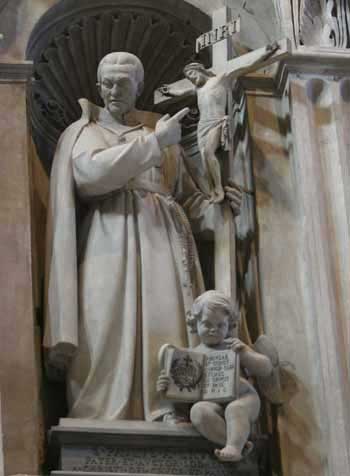 At holy Communion I had much sweetness. My dear God gave me infused knowledge of the joy which the soul will have when we see him face to face, when we will be united with Him in holy love. Then I felt sorrow to see Him offended and I told Him that I would willingly be torn to pieces for a single soul. Indeed, I felt that I would die when I saw the loss of so many souls who do not experience the fruit of the Passion of Jesus.-St. Paul of the Cross
At holy Communion I had much sweetness. My dear God gave me infused knowledge of the joy which the soul will have when we see him face to face, when we will be united with Him in holy love. Then I felt sorrow to see Him offended and I told Him that I would willingly be torn to pieces for a single soul. Indeed, I felt that I would die when I saw the loss of so many souls who do not experience the fruit of the Passion of Jesus.-St. Paul of the Cross
Oh my good God, how gentle You are! How sweet You are! Oh dear cross, I embrace you and press you to my heart!-St. Paul of the Cross
May the mercy of God grant you still more time in life so that you can become completely crucified with the Divine Spouse by means of mystical death, death to everything that is not God, with a continual detachment from all created things, wholly concealed in the divine bosom of the celestial Father in true inner solitude. Do not live any longer in yourself, but let Jesus Christ live in you in such a way that the virtue of this Divine Savior may be resplendent in all your actions, in order that all may see in you a true portrait of the Crucified and sense the sweetest fragrance of the holy virtues of the Lord, in interior and exterior modesty, in patience, in gentleness, suffering, charity, humility, and in all others that follow. -St. Paul of the Cross
Tags: catholic, catholic podcast, catholic prayer, cathollc spirituality, mystic, mystic of the Church, passion of christ, paul of christ, Paul of the Cross, Saint Paul, st, st. paul, the passionist
This entry was posted on Thursday, October 20th, 2011 at 12:09 am
You can follow any responses to this entry through the RSS 2.0 feed.
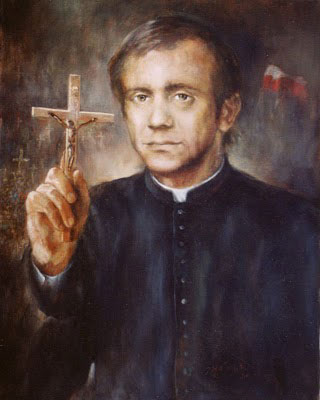 From Pope Benedict XVI, an excerpt
From Pope Benedict XVI, an excerpt
Another figure I wish to remember: Fr Jerzy Popiełuszko, a priest and martyr who was proclaimed Blessed in Warsaw precisely last Sunday. He exercised his generous and courageous ministry beside all those who were working for freedom, for the defence of life and for its dignity. His work at the service of goodness and truth was a sign of contradiction for the regime governing Poland at the time. Love of the Heart of Christ led him to give his life and his witness was the seed of a new springtime in the Church and in society. If we look at history, we can note how many pages of authentic spiritual and social renewal were written with the crucial contribution of Catholic priests, motivated solely by passion for the Gospel and for human beings and for their true freedom, both religious and civil. How many initiatives of integral human promotion have been born from the intuition of a priestly heart!
Dear brothers and sisters, let us entrust all the priests in the world to the Immaculate Heart of Mary, whose liturgical Memorial we celebrated yesterday, so that they may continue with the power of the Gospel to build everywhere the civilization of love.
Tags: Blessed Jerzy Popieluszko, catholic, catholic podcast, catholic prayer, cathollc spirituality, martyr, martyrdom, pope benedict xvi
This entry was posted on Wednesday, October 19th, 2011 at 7:47 am
You can follow any responses to this entry through the RSS 2.0 feed.
Mother of those who place their hope in Solidarity, pray for us.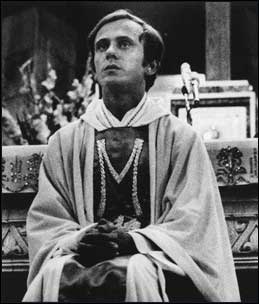
Mother of those who are deceived, pray for us.
Mother of those who are betrayed, pray for us.
Mother of those who are arrested in the night, pray for us.
Mother of those who are imprisoned, pray for us.
Mother of those who suffer from the cold, pray for us.
Mother of those who have been frightened, pray for us.
Mother of those who were subjected to interrogations, pray for us.
Mother of those innocents who have been condemned, pray for us.
Mother of those who speak the truth, pray for us.
Mother of those who cannot be corrupted, pray for us.
Mother of those who resist, pray for us.
Mother of orphans, pray for us.
Mother of those who have been molested because they wore your image, pray for us.
Mother of those who are forced to sign declarations contrary to their conscience, pray for us.
Mother of mothers who weep, pray for us.
Mother of fathers who have been so deeply saddened, pray for us.
Mother of our suffering country _____, pray for us.
Mother of our faithful country _____, pray for us.
We beg you, O mother in whom resides the hope of millions of people, grant us to live in liberty and in truth, in fidelity to you and to your Son. Amen.
Tags: blessed mother, blessed virgin mary, catholic, catholic podcast, catholic prayer, cathollc spirituality, hope, liberty, mother, prayer, suffering, truth
This entry was posted on Wednesday, October 19th, 2011 at 6:00 am
You can follow any responses to this entry through the RSS 2.0 feed.
 Mark Hart “The Bible Geek” talks to us about the importance of St. Luke
Mark Hart “The Bible Geek” talks to us about the importance of St. Luke
[powerpress]
Luke was a Greco-Syrian physician who lived in the Greek city of Antioch in Ancient Syria.
His earliest notice is in Paul’s Epistle to Philemon, verse 24. He is also mentioned in Colossians 4:14 and 2 Timothy 4:11, two works commonly ascribed to Paul. The next earliest account of Luke is in the Anti-Marcionite Prologue to the Gospel of Luke, a document once thought to date to the 2nd century, but which has more recently been dated to the later 4th century.
If one accepts that Luke was in fact the author of the Gospel bearing his name and also the Acts of the Apostles, certain details of his personal life can be reasonably assumed. While he does exclude himself from those who were eyewitnesses to Jesus’ ministry, he repeatedly uses the word “we” in describing the Pauline missions in Acts of the Apostles, indicating that he was personally there at those times.[9]Epiphanius states that Luke was one of the Seventy (Panarion 51.11), and John Chrysostom indicates at one point that the “brother” Paul mentions in 2 Corinthians 8:18 is either Luke or Barnabas. J. Wenham asserts that Luke was “one of the Seventy, the Emmaus disciple, Lucius of Cyrene and Paul’s kinsman.” Not all scholars are as confident of all of these attributes as Wenham is, not least because Luke’s own statement at the beginning of the Gospel of Luke (1:1–4) freely admits that he was not an eyewitness to the events of the Gospel.
There is similar evidence that Luke resided in Troas, the province which included the ruins of ancient Troy, in that he writes in Acts in the third person about Paul and his travels until they get to Troas, where he switches to the first person plural. The “we” section of Acts continues until the group leaves Philippi, when his writing goes back to the third person. This change happens again when the group returns to Philippi. There are three “we sections” in Acts, all following this rule. Luke never stated, however, that he lived in Troas, and this is the only evidence that he did.
The composition of the writings, as well as the range of vocabulary used, indicate that the author was an educated man. The quote in the Letter of Paul to the Colossians differentiating between Luke and other colleagues “of the circumcision”[10] has caused many to speculate that this indicates Luke was a Gentile. If this were true, it would make Luke the only writer of the New Testament who can clearly be identified as not being Jewish. However, that is not the only possibility. The phrase could just as easily be used to differentiate between those Christians who strictly observed the rituals of Judaism and those who did not.[9]
Luke died at age 84 in Boeotia, according to a “fairly early and widespread tradition”.[11] According to Nikiphoros-Kallistos Xanthopoulos (Eccles. History XIVth c. AD., Migne P.G. 145, 876) and others, Luke’s Tomb was located in Thebes (Greece), from whence his relics were transferred to Constantinople in the year 357.
Luke as a historian
Most scholars understand Luke’s works (Luke-Acts) in the tradition of Greek historiography. The preface of The Gospel of Luke (1:1-4) drawing on historical investigation is believed to have identified the work to the readers as belonging to the genre of history. There is some disagreement about how best to treat Luke’s writings, with some historians regarding Luke as highly accurate, and others taking a more critical approach.Archaeologist Sir William Ramsay wrote that “Luke is a historian of the first rank; not merely are his statements of fact trustworthy…[he] should be placed along with the very greatest of historians.” Professor of classics at Auckland University, E.M. Blaiklock, wrote: “For accuracy of detail, and for evocation of atmosphere, Luke stands, in fact, with Thucydides. The Acts of the Apostles is not shoddy product of pious imagining, but a trustworthy record…it was the spadework of archaeology which first revealed the truth.”  New Testament scholar Colin Hemer has made a number of advancements in understanding the historical nature and accuracy of Luke’s writings.Â
Luke as an artist
Another Christian tradition states that he was the first icon painter. He is said to have painted pictures of the Virgin Mary (for example, The Black Madonna of CzÄ™stochowa or Our Lady of Vladimir) and of Peter and Paul. Thus late medieval Guilds of St Luke in the cities of Flanders, or the “Accademia di San Luca” (Academy of St. Luke) in Rome–imitated in many other European cities during the 16th century–gathered together and protected painters. The tradition that Luke painted icons of Mary and Jesus has been common, particularly in Eastern Orthodoxy. The tradition also has support from the Saint Thomas Christiansof India who claim to still have one of the Theotokos icons that St. Luke painted and which St. Thomas brought to India.ÂNew Testament books
- See also Gospel of Luke  and Acts of the Apostles
Some scholars attribute to Luke the third Gospel and the Acts of the Apostles, which is clearly meant to be read as a sequel to the Gospel account. Other scholars question Luke’s authorship of these books. Many secular scholars give credit to Luke’s abilities as a historian. Both books are dedicated to oneTheophilus and no scholar seriously doubts that the same person wrote both works, though neither work contains the name of its author.
Many argue that the author of the book must have been a companion of the Apostle Paul, because of several passages in Acts written in the first person plural (known as the We Sections). These verses seem to indicate the author was traveling with Paul during parts of his journeys. Some scholars report that, of the colleagues that Paul mentions in his epistles, the process of elimination leaves Luke as the only person who fits everything known about the author of Luke/Acts.
Additionally, the earliest manuscript of the Gospel, dated circa AD 200, ascribes the work to Luke; as did Irenaeus, writing circa AD 180; and the Muratorian fragment from AD 170. Scholars defending Luke’s authorship say there is no reason for early Christians to attribute these works to such a minor figure if he did not in fact write them, nor is there any tradition attributing this work to any other author.
The ox as symbol of St. LukeIn traditional depictions, such as paintings, evangelist portraits and church mosaics, St. Luke is often accompanied by an ox or bull, usually having wings. Also, only the symbol may be shown, especially when in a combination of those of all Four Evangelists.
Tags: catholic, catholic podcast, catholic prayer, cathollc spirituality, gospel of luke, life teen
This entry was posted on Tuesday, October 18th, 2011 at 10:19 am
You can follow any responses to this entry through the RSS 2.0 feed.
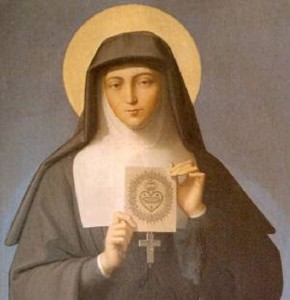 Upon visiting the Chapel of the Apparition in
Upon visiting the Chapel of the Apparition in  Paray le Monial during the 1st Sacred Heart World Congress, Msgr. Esseff reflects on the meaning of the Sacred Heart for St. Margaret Mary, her experience and ours today.
Paray le Monial during the 1st Sacred Heart World Congress, Msgr. Esseff reflects on the meaning of the Sacred Heart for St. Margaret Mary, her experience and ours today.
[powerpress]
At that particular moment it felt as though there was a beating of the Sacred Heart, similiar to what must have been experienced by St. Margaret Mary. “Behold the heart that has loved so much that has received so little love in return.”
Check out Msgr. John Esseff’s website: Â Building a Kingdom of Love
Tags: catholic, catholic podcast, catholic prayer, cathollc spirituality, margaret mary alacoque, msgr. john esseff, sacred heart, sacred heart of jesus, St. Margaret Mary
This entry was posted on Monday, October 17th, 2011 at 2:24 pm
You can follow any responses to this entry through the RSS 2.0 feed.
A Prayer to Gerard Majella
[powerpress = “devotionals-prayers”]
Saint Gerard Majella April 6, 1726, Muro Lucano, Basilicata – October 16, 1755, He is the saint whose intercession is requested for children (and unborn children in particular), childbirth, mothers (and expectant mothers in particular), motherhood, falsely accused people, good confessions, lay brothers and just about anyone who desires the comfort of an understanding heart.
When he was born, he was given the name Gerard. He was the son of a tailor who died when Gerard was twelve, leaving the family in poverty. His mother then sent him to her brother so that he could teach Gerard how to sew and help the business. During this time, he was abused by a man whom his uncle sent to help him. He kept silent, but soon his uncle found out and the man who taught him resigned from the job. He loved to be like Jesus Crucified and tried at all costs to suffer. . He joined the Congregation of the Most Holy Redeemer in 1749. When falsely accused by a pregnant woman of being the father of her child, he retreated to silence. She later recanted and cleared him, and thus began his association as patron of all aspects of pregnancy. He was reputed to have bilocation and read consciences. His last will consisted of a small note on the door of his cell saying, “Here the will of God is done, as God wills, and as long as God wills.“ He died on October 16, 1755 in Caposele of tuberculosis, aged 29.
This very short synposis of his life does not do him justice, for more details of his life and so much more visit the website of the Redemptorists.Â
I found the best way to really know St. Gerard is to pray with him.  For a fuller listing of prayers and a novena to St. Gerard visit his Discerning Hearts page
Saint Gerard Prayers –
For Motherhood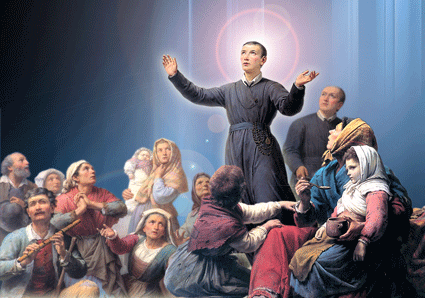
O good Saint Gerard, powerful intercessor before God and Wonderworker of our day, I call upon thee and seek thy aid. Thou who on earth didst always fulfill God’s designs, help me to do the holy Will of God. Beseech the Master of Life, from Whom all paternity proceedeth, to render me fruitful in offspring, that I may raise up children to God in this life and heirs to the Kingdom of His Glory in the world to come. Amen.
For Mother with Child
O almighty and Everlasting God Who through the operation of the Holy Christ, didst prepare the body and soul of the glorious Virgin Mary to be a worthy dwelling place of Thy divine Son; and, through the operation of the same Holy Ghost, didst sanctify Saint John the Baptist, while still in his mother’s womb; hearken to the prayers of Thy humble servant who implore thee, through the intercession of Saint Gerard, to protect her (me); that it may be cleansed by the saving water of baptism and, after a Christian life on earth, it may with its mother, attain everlasting bliss in Heaven. Amen.
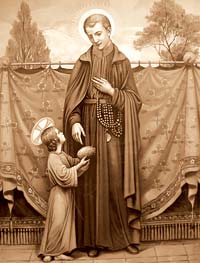 For a Sick Child
For a Sick Child
O Saint Gerard, who, like the Savior, loved children so tenderly and by your prayers freed many from disease and even from death; graciously look down upon the distressed parents who plead with thee for their child’s health if such be the Will, of God. Present their promise to God to bring up the child a good Christian and to guard it by word and example against the fatal leprosy of sin. This favor we implore thee, O sainted Brother, through the tender love with which Jesus and Mary blessed thy own innocent childhood. Amen.
In Time of Trial
O Sainted Brother Gerard, whose heart went out to the unfortunate; who relieved so many poor, healed so many sick, comforted so many afflicted; behold me worried and troubled as I kneel at thy feet. In vain to turn to men to seek consolation and help; therefore, do I have recourse to thee thou who art so powerful in heaven. Graciously assist me, Saint Gerard, that being freed from this trial or strengthened to bear it for the love of God, I may praise and thank God and serve Him with greater love and fervor. Amen.
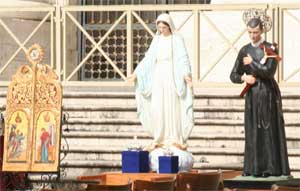 When in Rome, during the Wednesday audience, we saw them bring out a statue of St. Gerard to be blessed by our Holy Father, Pope Benedict. Of course, it would be blessed along with an image of Our Lady. I am sure wherever this statue is now, there are many candles lit requesting this wonderful saints intercession. May all their prayers be answered. St. Gerard Majella, pray for us.
When in Rome, during the Wednesday audience, we saw them bring out a statue of St. Gerard to be blessed by our Holy Father, Pope Benedict. Of course, it would be blessed along with an image of Our Lady. I am sure wherever this statue is now, there are many candles lit requesting this wonderful saints intercession. May all their prayers be answered. St. Gerard Majella, pray for us.
Tags: catholic, catholic podcast, catholic prayer, cathollc spirituality, childbirth, difficult pregnancy, gerard majella, motherhood, mothers, prayer, unwed mothers
This entry was posted on Sunday, October 16th, 2011 at 8:10 am
You can follow any responses to this entry through the RSS 2.0 feed.
[powerpress feed = “devotionals-prayers”]
St. Teresa of Avila was a Carmelite nun and a Spanish mystic. She is also known as “St. Teresa of Jesus” or the “Great St. Teresa” to distinguish her from another Carmelite nun, St. Therese of Lisieux (1873-1897) known as “The Little Flower. St. Teresa of Avila is a very much-loved contemplative Catholic saint
She was Teresa de Cepeda y Ahumada, a child of a noble family, born on March 28, 1515 at Avila in Castile. Her mother died when she was fifteen. This event upset her so much that her father sent her to an Augustinian convent in Avila. Her father brought her home after a year and a half when she became ill. After being exposed to monastic life she wished to become a nun, which her father forbade as long as he was living. At the age or twenty or twenty-one she secretly left home and entered the Incarnation of the Carmelite nuns in Avila, after which her father dropped his opposition.
Much of St. Teresa’s life was plagued by illness. In 1538 it appears she suffered from malaria when her father took her from the convent and placed her under doctors care. Despite of this she remained ill and undertook experimental cures by a woman in the town of Becedas. These methods left her in a coma for three days and not able to walk for three years. It was during this time of illness and convalescence that she took to daily mental prayer, which led to her experiences with mystical prayer. She credited her recovery to St. Joseph.
St. Teresa never sought out the mystical experiences that she experienced, but resigned herself to God’s will and considers the experiences a divine blessing. She spent long hours in meditation that she called the “prayer of quiet” and the “prayer of union.” During such prayers she frequently went into a trance, and at times entered upon mystical flights in which she would feel as if her soul were lifted out of her body. She said ecstasy was like a “detachable death” and her soul became awake to God as never before when the faculties and senses are dead.
St. Teresa being a contemplative is well known for her discussion on the grades of prayer through which the soul is focused upon the love of God passes before reaching the “central mansion” of the soul, where Christ lives. She distinguished sharply between the essence of mysticism, which is loving the contemplation of God infused by God’s own love and grace, and the tangential phenomena that may accompany the contemplative life, such as visions, audible sensations, ecstasy, levitation, and stigmata. She, as others, believed that Satan could manipulate such phenomena to corrupt the gullible even when they come from God. St. Teresa felt that the Devil could twist such things in order to cause the individual to be more concerned with these manifestations than with their true mission of loving God entirely.
Although St. Teresa warned against taking the powers of the Devil too seriously, and advised that his powers should be despised (tener en poco). She said Satan was constantly active against Christians, especially the contemplative, trying intensely to block them from their goal of achieving absolute union with God. Although the Devil was powerless against the defense that Christ builds up in a faithful soul, he will rush in at the person’s weakness moments to suggest things that appear reasonable and good but invariably result in feelings of confusion, worthlessness and disgust. He put for ingeniously devised temptations: he encourages self-righteousness and false humility and discourages us from prayer; he causes us to feel guilty for
having received God’s grace and to labor under the impossible burden of trying to earn it; he makes us ill- tempered toward others; he creates illusions and distractions in the intellect; he inspires the doubt and fear that the understanding that we are granted in contemplation is an illusion. Sometimes we feel that we have lost control of our souls, as if demons are tossing us back and forth like balls. Sometimes we feel that we have made no progress, but even when the boat is becalmed, God is secretly stirring in the sails and moving us along.
In 1562, against opposition, she founded a convent in Avila with stricter rules that those that prevailed in Carmelite monasteries. She was determined to establish a small community that would follow the Carmelite contemplative life, especially unceasing prayer. In 1567 she was given permission to establish other convents, and eventually founded seventeen others. She dedicated herself to reforming the Carmelite order. When St. Teresa was fifty-three she met the twenty-six-year-old St. John of the Cross, who was dedicated to reforming the male Carmelite monasteries. Following a period of turbulence within the Carmelites, from 1575 to 1580, the Discalced Reform was recognized as separate.
As St. Teresa was traveling about Spain founding her reformed Carmelite convents her pen was busy too. All of her books have become spiritual classics. Life, her first work and autobiography written in 1565, describes how she experienced a spiritual marriage with Christ as bridegroom to the soul; she had this experience on November 18, 1572. Following this experience she wrote The Way of Perfection (1573), about the life of prayer. This was followed by The Interior Castle (1577), her best-known work, in which she presents a spiritual doctrine using a castle to symbolize the interior life. This latter book was revealed to her on Trinity Sunday, 1577, in which she saw a crystal globe like a castle that contained seven rooms; the seventh, in the center, held the King of Glory. One approached the center, which represents the Union with God, by going through the other rooms of Humility, Practice of Prayer, Meditation, Quiet, Illumination, and Dark Night.
After founding her last convent at Burgos, in 1582, St. Teresa returned in very poor health to Avila. The difficult journey proved to have been too much for her frail condition. She took to her deathbed upon her arrival at the convent and died three days later on October 4, 1582. The next day the Gregorian Calendar went into effect, thus dropping ten days and making her death on October 14. Her feast day is October 15.
St. Teresa was canonized in 1662 by Pope Gregory XV and was declared doctor of the Church, the first woman so honored, in 1970 by Pope Paul VI – The Mystica
Tags: carmelite nuns, catholic, catholic podcast, catholic prayer, cathollc spirituality, mystic, mystic of the Church, mystical experiences, mystical prayer, st teresa of jesus, st. teresa of avila
This entry was posted on Saturday, October 15th, 2011 at 10:41 pm
You can follow any responses to this entry through the RSS 2.0 feed.
God, deliver me from sullen saints. – Saint Teresa of Avila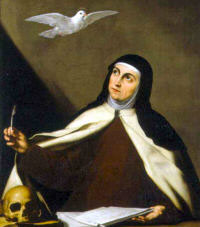
Oh my Lord! How true it is that whoever works for you is paid in troubles! And what a precious price to those who love you if we understand its value. – Saint Teresa of Avila
There is no such thing as bad weather. All weather is good because it is God’s. – Saint Teresa of Avila
There is more value in a little study of humility and in a single act of it than in all the knowledge in the world. – Saint Teresa of Avila
We need no wings to go in search of Him, but have only to look upon Him present within us. – Saint Teresa of Avila
Let nothing trouble you, let nothing make you afraid. All things pass away. God never changes. Patience obtains everything. God alone is enough. – Saint Teresa of Avila
Dream that the more you struggle, the more you prove the love that you bear your God, and the more you will rejoice one day with your Beloved, in a happiness and rapture that can never end. – Saint Teresa of Avila
Hope, O my soul, hope. You know neither the day nor the hour. Watch carefully, for everything passes quickly, even though your impatience makes doubtful what is certain, and turns a very short time into a long one. – Saint Teresa of Avila
You ought to make every effort to free yourselves even from venial sin, and to do what is most perfect. – Saint Teresa of Avila
If Christ Jesus dwells in a man as his friend and noble leader, that man can endure all things, for Christ helps and strengthens us and never abandons us. He is a true friend. And I clearly see that is we expect to please him and receive an abundance of his graces, God desires that these graces must come to us from the hands of Christ, through his most sacred humanity, in which God takes delight. All blessings come to us through our Lord. He will teach us, for in beholding his life we find that he is the best example. What more do we desire from such a good friend at our side? Unlike our friends in the world, he will never abandon us when we are troubled or distressed. Blessed is the one who truly loves him and always keeps him near. Whenever we think of Christ we should recall the love that led him to bestow on us so many graces and favors, and also the great love God showed in giving us in Christ a pledge of his love; for love calls for love in return. Let us strive to keep this always before our eyes and to rouse ourselves to love him. For is at some time the Lord should grant us the grace of impressing his love on our hearts, all will become easy for us and we shall accomplish great things quickly and without effort. – Saint Teresa of Avila
“I do not fear Satan half so much as I fear those who fear him.”– Saint Teresa of Avila
“To have courage for whatever comes in life – everything lies in that.”– Saint Teresa of Avila
“To reach something good it is very useful to have gone astray, and thus acquire experience.”– Saint Teresa of Avila
“We can only learn to know ourselves and do what we can – namely, surrender our will and fulfill God’s will in us.”– Saint Teresa of Avila
 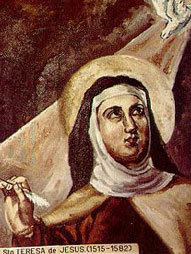 “We shall never learn to know ourselves except by endeavoring to know God; for, beholding His greatness, we realize our own littleness; His purity shows us our foulness; and by meditating upon His humility we find how very far we are from being humble.”– Saint Teresa of Avila
“We shall never learn to know ourselves except by endeavoring to know God; for, beholding His greatness, we realize our own littleness; His purity shows us our foulness; and by meditating upon His humility we find how very far we are from being humble.”– Saint Teresa of Avila
“There are more tears shed over answered prayers than over unanswered prayers.”– Saint Teresa of Avila
“It is here, my daughters, that love is to be found – not hidden away in corners but in the midst of occasions of sin. And believe me, although we may more often fail and commit small lapses, our gain will be incomparably the greater.”– Saint Teresa of Avila
“The tree that is beside the running water is fresher and gives more fruit.”– Saint Teresa of Avila
“O my God, what must a soul be like when it is in this state! It longs to be all one tongue with which to praise the Lord. It utters a thousand pious follies, in a continuous endeavor to please Him who thus possesses it.”– Saint Teresa of Avila
“Our body has this defect that, the more it is provided care and comforts, the more needs and desires it finds. “– Saint Teresa of Avila
“The feeling remains that God is on the journey, too.”– Saint Teresa of Avila
Tags: catholic, catholic podcast, catholic prayer, cathollc spirituality, humility, quotes, saint teresa of avila, Teresa of Avila
This entry was posted on Saturday, October 15th, 2011 at 8:37 am
You can follow any responses to this entry through the RSS 2.0 feed.
The Novena to St. Teresa of Avila, Day 7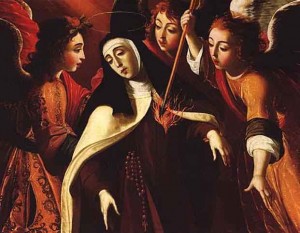
composed by  by St. Alphonsus of Liguori.
Join in on Day 7 [powerpress = “devotionals-prayers”]
O most loving Lord Jesus Christ! we thank Thee for the wonderful gift of the wound in the heart which Thou didst grant to Thy beloved Teresa; we pray Thee, by Thy merits, and by those of Thy seraphic spouse, to grant us also a like wound of love, that, henceforth, we may love Thee and give our mind to the love of nothing but Thee.
Say one Our Father, Hail Mary and Glory be.
V. St. Teresa, pray for us:
R. That we may become worthy of the promises of Jesus Christ.
Let us pray: Graciously hear us, O God of our salvation! that as we rejoice in the commemoration of the blessed virgin Teresa, so we may be nourished by her heavenly doctrine, and draw from thence the fervour of a tender devotion; through our Lord Jesus Christ, Thy Son, Who liveth and reigneth with Thee in the unity of the Holy Spirit, God for ever and ever. Amen.
Tags: catholic, catholic podcast, catholic prayer, cathollc spirituality, st alphonsus, st teresa
This entry was posted on Wednesday, October 12th, 2011 at 12:05 am
You can follow any responses to this entry through the RSS 2.0 feed.

